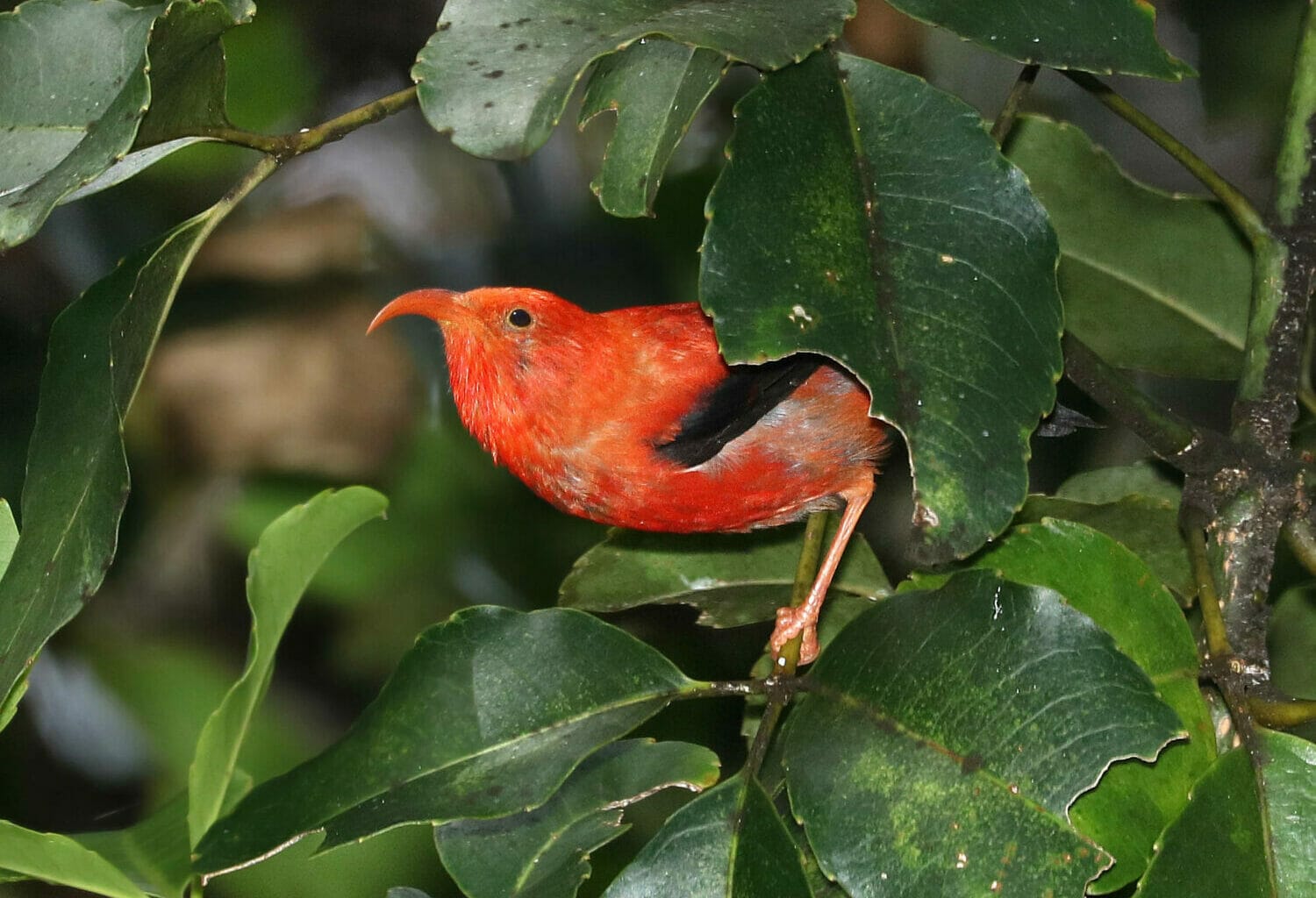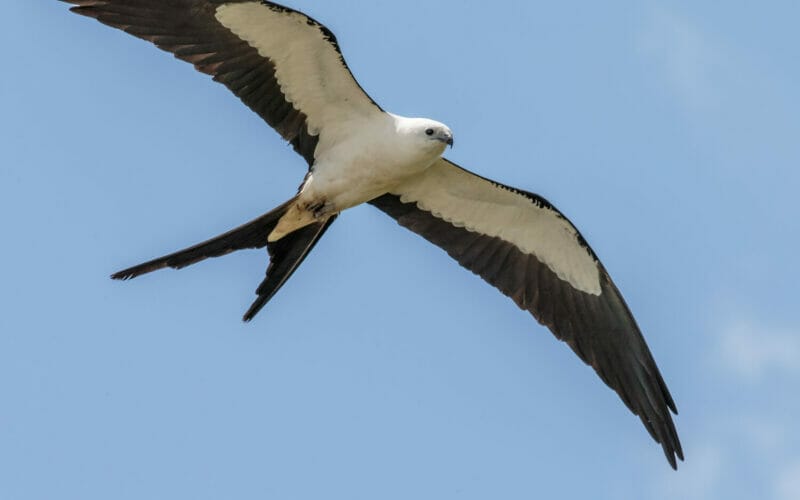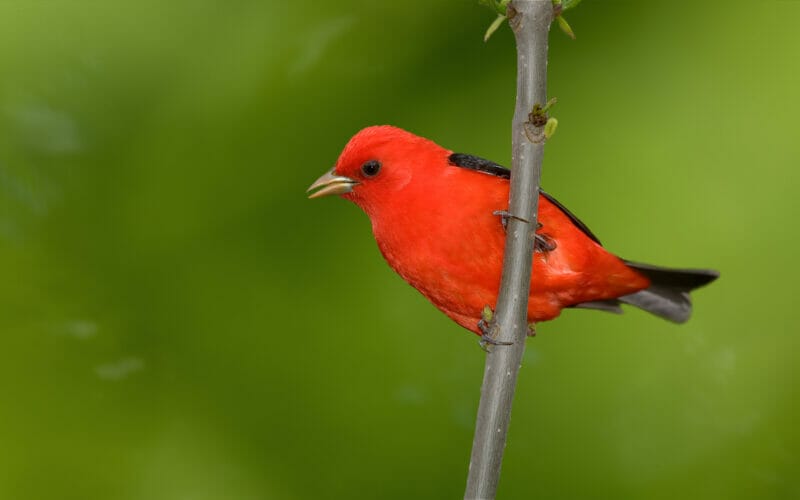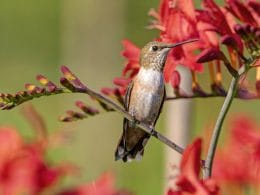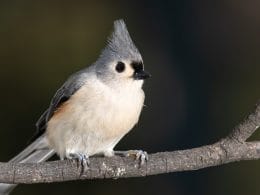The isolated, sea-bound location of the State of Hawaii means it inevitably has unique flora and fauna. From visiting seabirds to endemic bush birds, there is nowhere quite like this archipelago for an unforgettable wildlife experience. In this post we will be looking at a mix of the birds found here, from rare to common, endemic and visitors, land and sea.

The State of Hawaii
While there are approximately 132 islands in the Hawaiian archipelago, there are 8 main islands all in the eastern most area. Nearly all of the population of the state live on this islands and the biggest is Hawaii Island itself, often referred to as Big Island. All the islands are the visible tips of a huge range of volcanoes and there is ongoing volcanic activity today. Hawaii is situated close to the center of the Pacific Ocean and is the most isolated American state, with the nearest city being San Francisco some 2,400 miles to the east.
The climate of Hawaii consists of 2 seasons: kau is the dry season from May to October and hoʻoilo is the wet season from November to April. Having said that, the temperature remains fairly consistent and is a pleasant 78° in the summer period. The nature of the islands’ geographies make them diverse, with many micro-climates creating a range of environments and thus, plants and birds.
Birds of Hawaii
The state bird of Hawaii is the Nene Goose. It is a sedate bird but certainly one of the more attractive goose species. The counties of Honolulu and Hawaii are considered the best for bird watching and a large number of the state’s endemics can be seen in their national parks. Like all places, Hawaii has birds that can be commonly seen. However, they are so unique to the area, that common becomes a relative term.
Hawaii ranks at 51 out of 51 U.S. states at 277 recorded bird species according to eBird, with some 220,000 submitted lists. However, you might see some birds that can be sighted elsewhere (albatross, tropicbirds, cardinals and myna, for example) but you will also see some incredibly rare and specialized birds that have developed in response to this remote and geographically diverse environment. Furthermore, the potential bird count might appear low but you will still see more species than somewhere like New Zealand! A new visitor to the islands of Hawaii won’t be disappointed.
Hawaiian Birds: Top 10
‘Apapane (Himatione sanguinea)

Identification and Size
The ‘Apapane is a vivid scarlet honeycreeper with a dark bill and wing bars. The juvenile is a mid-brown color but also has the dark wing bars.
Length: 5.1 inches
Weight: 0.51 – 0.56 ounces
Distribution
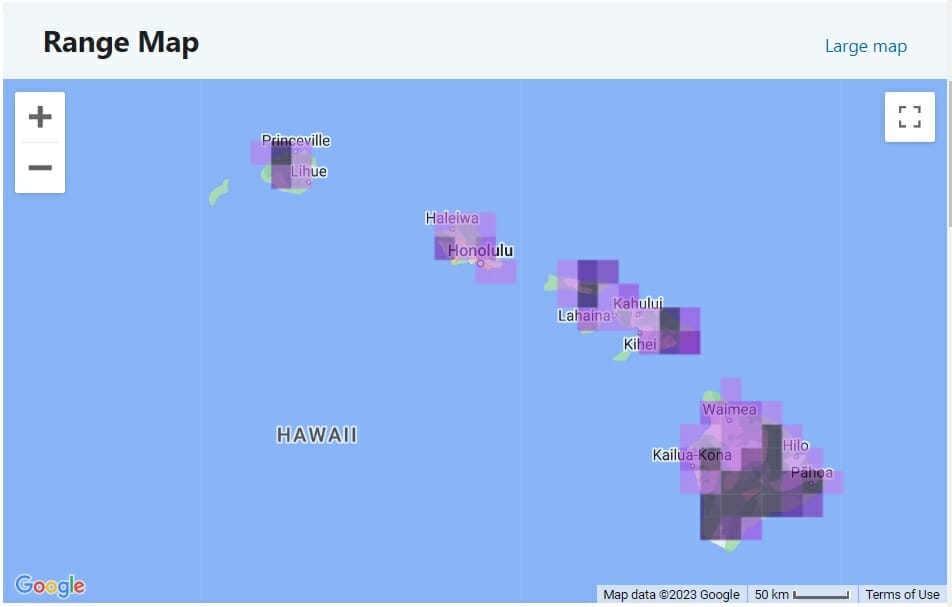
The ‘Apapane can be seen in areas across most the main islands all year round. Usually seen high up in the canopy it may be present at lower and higher elevations.

Call
Diet
The ‘Apapane primarily eats the nectar of native plants but it will take advantage of local invertebrate populations as well.
Interesting Fact
The male bird has a wide range of songs for different occasions like courtship and egg incubation. These birds were highly prized and their feathers were incorporated into the dress of local nobility.
ʻAkohekohe (Palmeria dolei)
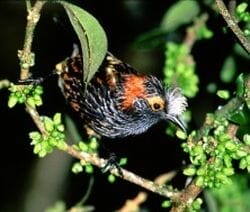
Identification and Size
This critically endangered honeycreeper is largely black with pale streaks down its breast and orange markings across the back. A pale eye patch and bright orange neck is worn with a pale white/yellow crest on the head.
Length: 6.5 – 7 inches
Weight: 1.5 – 2 ounces
Distribution

The ʻAkohekohe can only be found in the tropical forests on the eastern side of Maui, where access is restricted. It is present all year round but difficult to see.

Call
Diet
A nectivorous bird that will supplement its regular diet with seasonal nectar found in its range. It will also eat insects, caterpillars and spiders.
Interesting Fact
Also called the Crested Honeycreeper, the ʻAkohekohe is known for its acrobatics, either in pursuit of blossoms in the top of the canopy or during courtship to impress the female.
Red-billed Leiothrix (Leiothrix lutea)

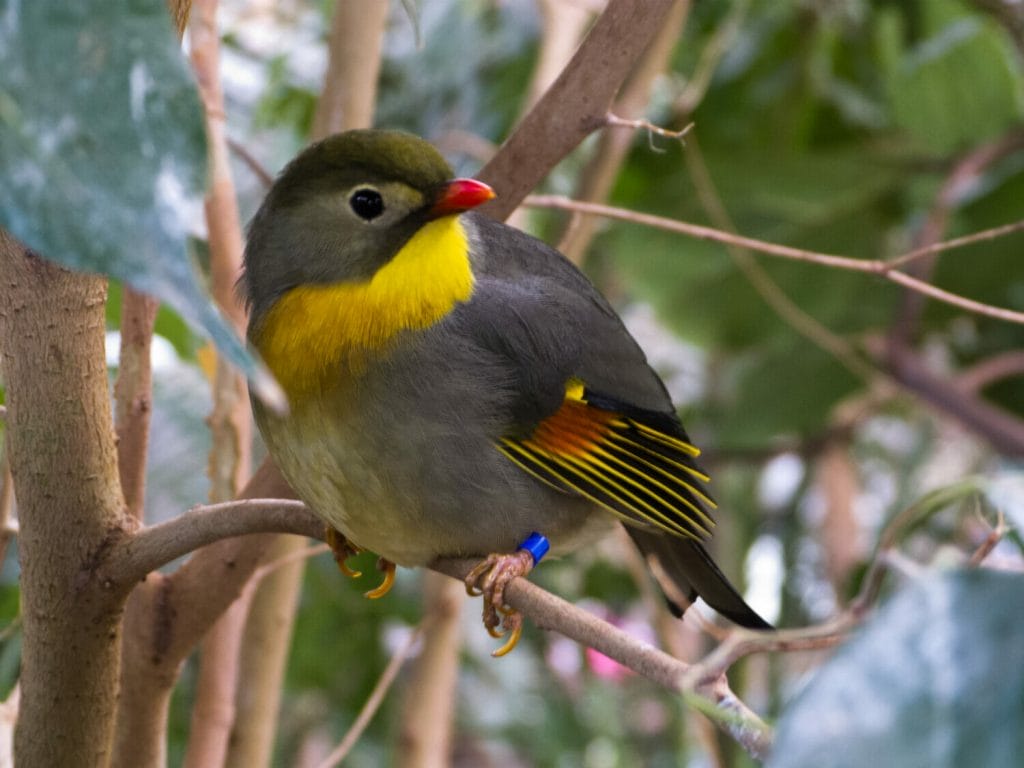
Identification and Size
This is a brightly colored babbler with a vivid yellow throat and distinctive red bill. It has yellow, orange and black alternating stripes on the wing.
Length: 5.5 – 5.9 inches
Weight: 0.63 – 0.99 ounces
Distribution
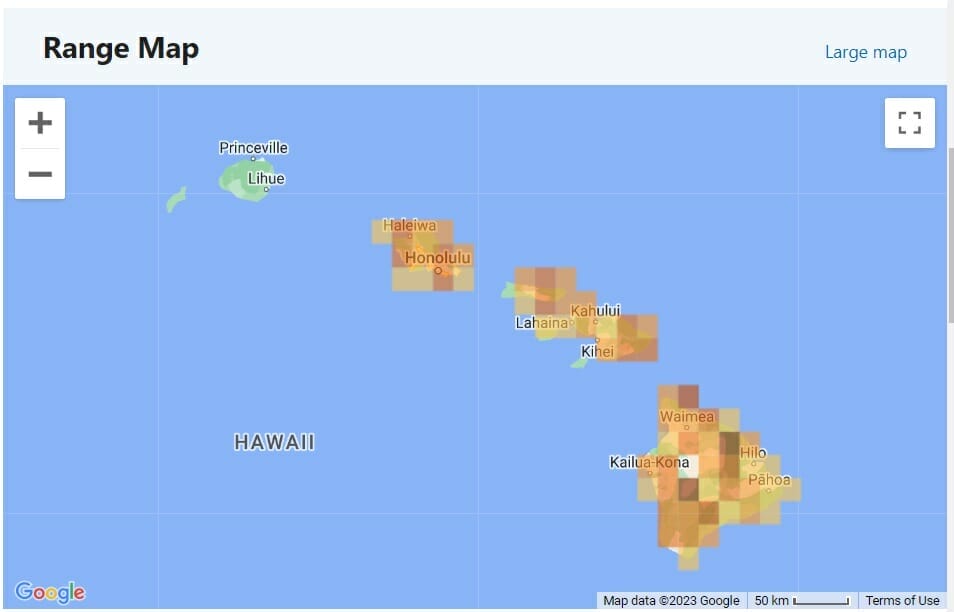
Introduced to Hawaii from Asia, the Red-billed Leiothrix can be found all year round across the main islands.

Call
Due to the sensitivity of illegal capture of this bird, calls are restricted and we respect that.
Diet
These birds love fruits, from local ‘äkala (Rubus hawaiiensis) to introduced strawberry species. They will also consume moths and butterflies when available.
Interesting Fact
Red-billed Leiothrix populations on differing island of Hawaii have been through huge changes with crashes and recovery. It is a target of illegal bird trading because of its popularity as a caged animal.
Laysan Albatross (Phoebastria immutabilis)
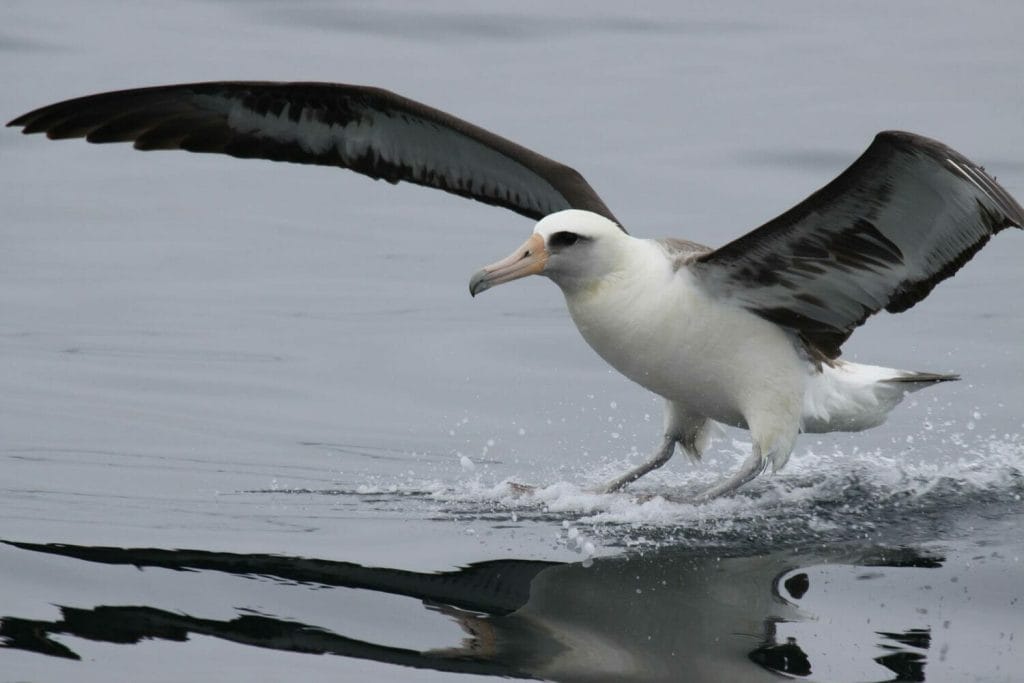

Identification and Size
The Laysan Albatross is unmistakeable with its large size and dark brow being diagnostic. The black of the wings extends across the body with black and white underwing patterns.
Length: 31.1 – 31.9 inches
Wingspan: 76.8 – 79.9 inches
Weight: 77.6 – 151.1 ounces
Distribution
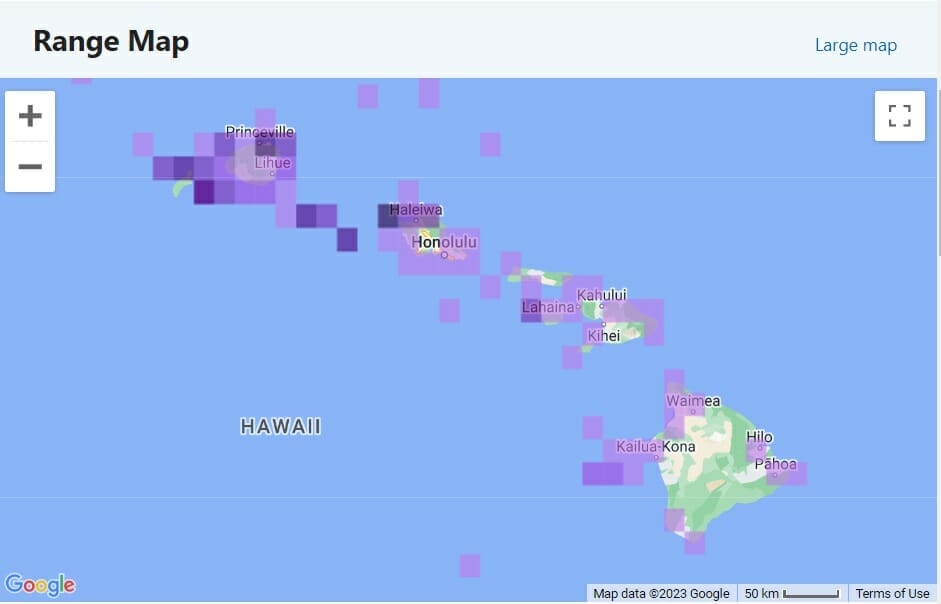
Breeding in Hawaii, the Laysan Albatross can be seen off the shores of all the main islands. It nests on the ground of the northwestern islands.

Call
Diet
While the Laysan Albatross will eat fish, its primary diet consists of squid.
Interesting Fact
Laysan Albatross can live very long lives. The oldest known bird was last identified by her leg bands and was 65 years old.
Hawaiian Hawk (Buteo solitarius)

Identification and Size
The Hawaiian Hawk is a stocky raptor with a noticeable short head and neck. Coloration varies but it is generally dark above and has pale to dark patches underneath.
Length: 16 – 18 inches
Weight: 15.6 – 21.3 ounces
Distribution
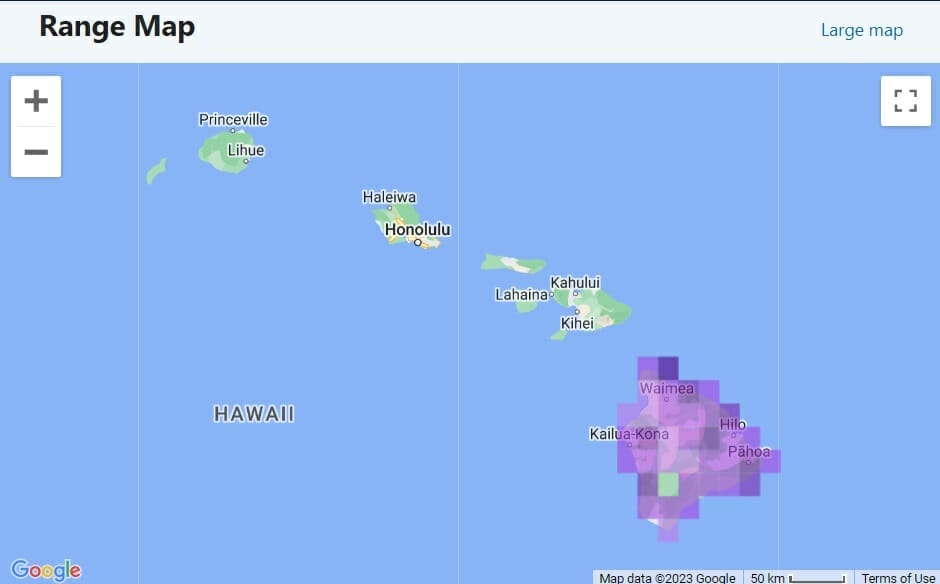
The Hawaiian Hawk can only be found on Hawaii Island and is the only resident hawk present. As such, it can be seen all year round.

Call
Diet
As a raptor, the Hawaiian Hawk is ever the opportunist. It will take many other species of birds, as well as rats and mice.
Interesting Fact
The Hawaiian Hawk is very loyal and fastidioius. It will adopt a territory and then defend it. Once mated, it remains monogomous.
Kauaʻi ʻElepaio (Chasiempis sclateri)

Identification and Size
The Kauaʻi ʻElepaio is a small flycatcher. Picture here is a juvenile with pale brown bars on the wing. Adults have gray and white wingbars.
Length: 5.51 inches
Weight: 0.42 – 0.63 ounces
Distribution
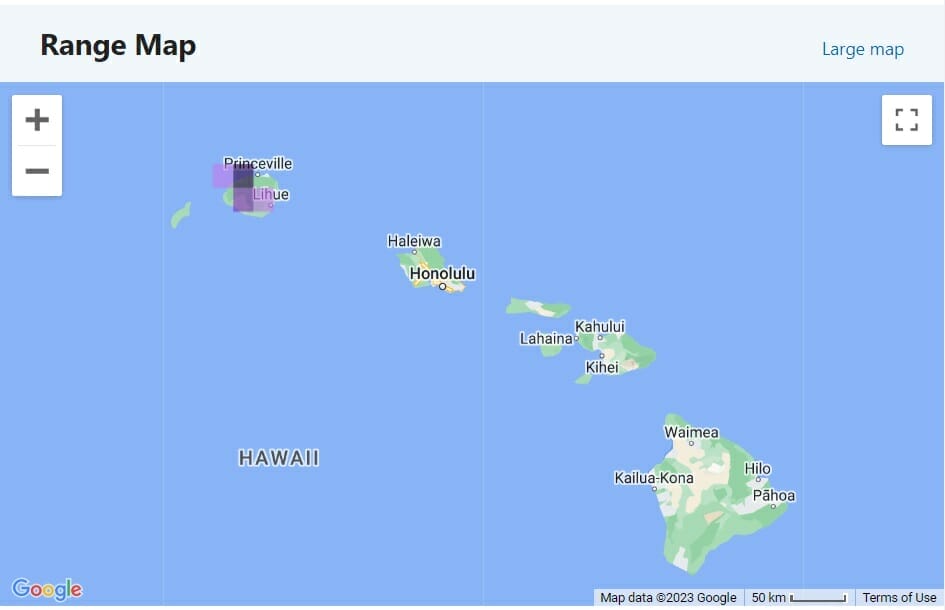
Only found on the island of Kauai, the Kauaʻi ʻElepaio inhabits the forested areas and is present all year round.

Call
Diet
Primarily feeding on insects and spiders, the Kauaʻi ʻElepaio will also take molluscs, moths and caterpillars.
Interesting Fact
The Kauaʻi ʻElepaio is an active bird and will start singing at first light and still call as night falls.
Nene Goose (Branta sandvicensis)
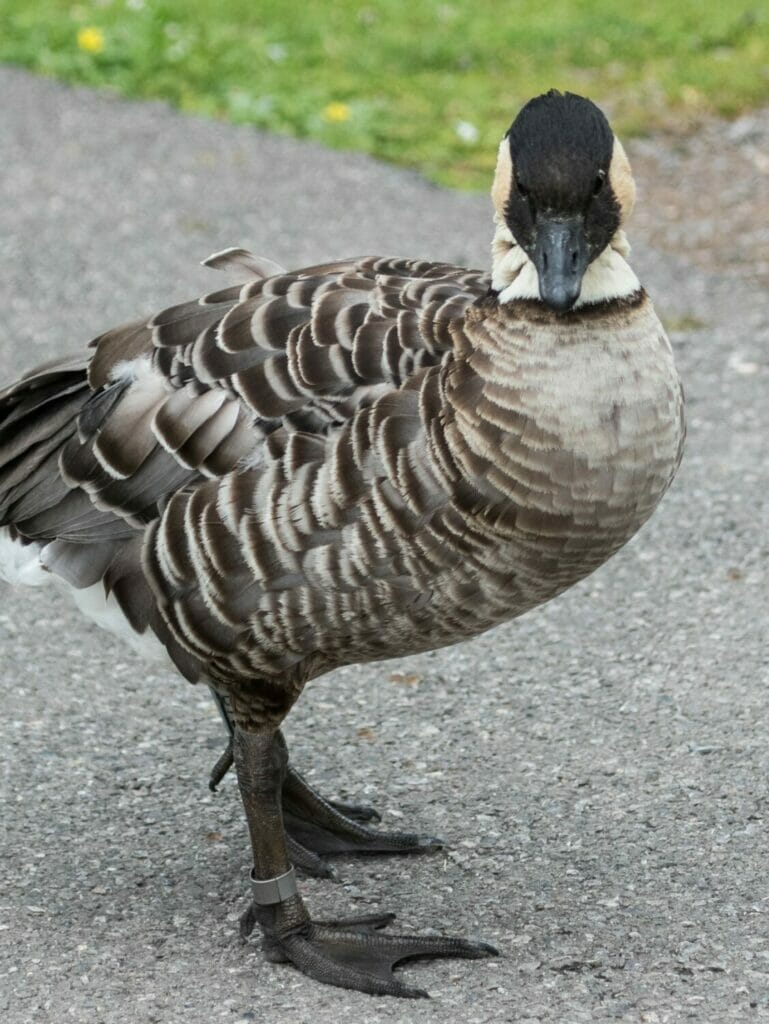

The Hawaiian or Nene Goose is an attractive water bird. It is pale underneath and darker from tail to head. Pale markings run up the back and the neck is creamy with darker feathers underneath.
Height: 16 inches
Weight: 3.36 – 6.72 pounds
Distribution
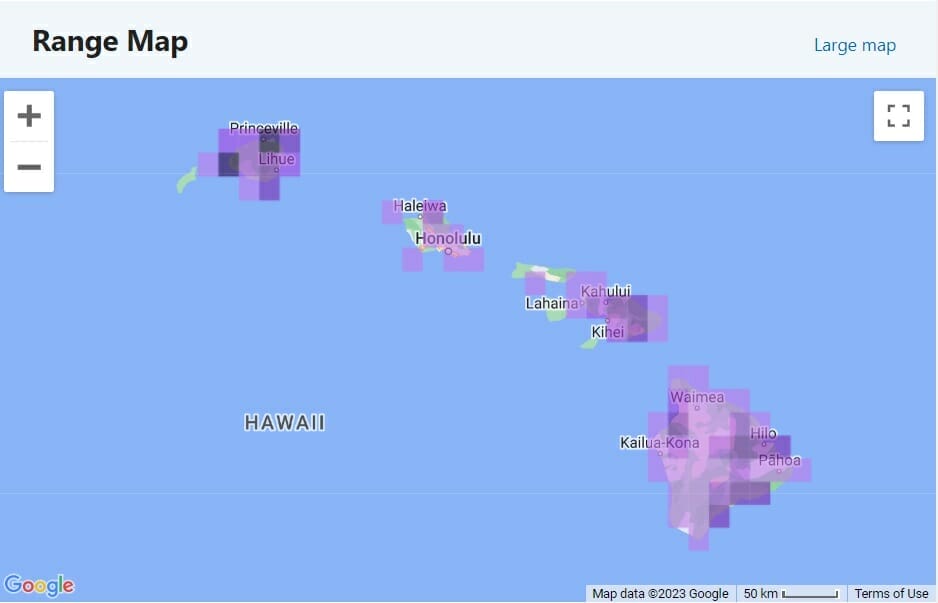
The Nene Goose can be found easily on Kauai and is common in places across the other main islands. It will venture into parks, ponds and other grassy areas. Seen all year round.

Call
Diet
The Nene Goose likes to graze on a wide variety of grasses, shrubs and herbs. While it has adapted and will eat foreign (but now established) plants, it still plays an important role in the seed dispersal of some rare, native plant species.
Interesting Fact
The Nene Goose have lost their webbed feet and their toes have become longer to cope with walking on the rough ground of Hawaii
‘Ōma’o (Myadestes obscurus)
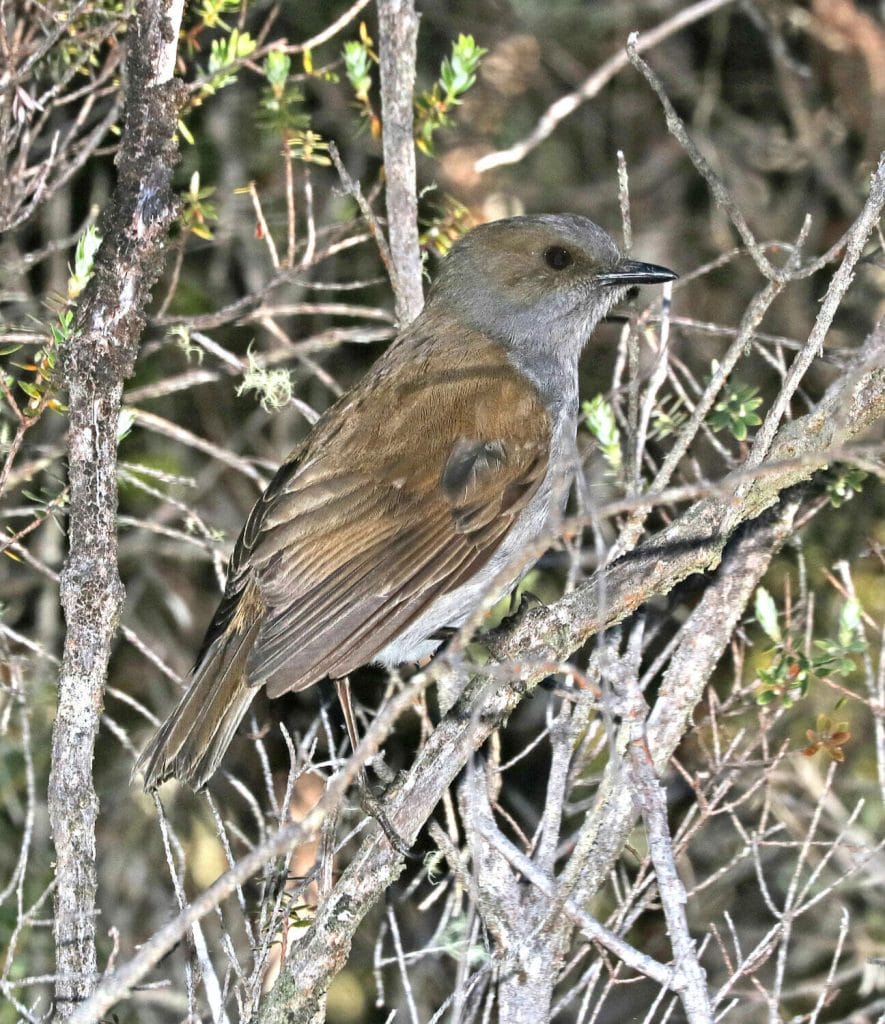
Identification
The ‘Ōma’o is a large member of the thrush family and blends in well to the forest areas it inhabits with its rather dull gray and brown plumage.
Length: 6.69 inches
Weight: 1.30 – 1.51 ounces
Distribution
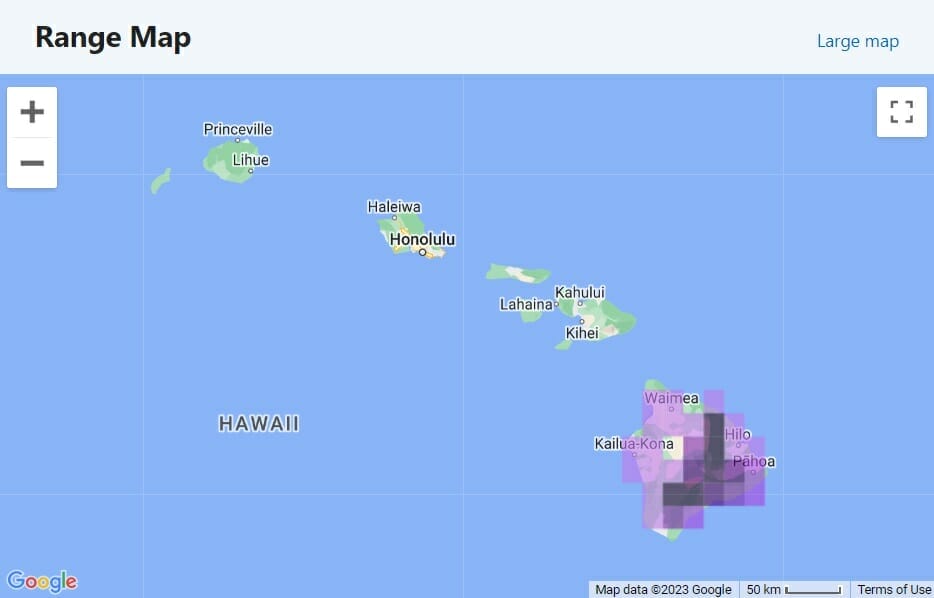
‘Ōma’o are found only in the high forests of the eastern side of Hawaii Island where they are present, but very hard to see, all year round.

Call
Diet
The ‘Ōma’o can be flexible in its diet. Its preference is fruit and it will be opportunistic about what it takes. Supplementing that are insects, bees and beetles.
Interesting Fact
This bird is known for its habit of quivering its wings when it is settled on a branch.
Maui Parrotbill (Pseudonestor xanthophrys)
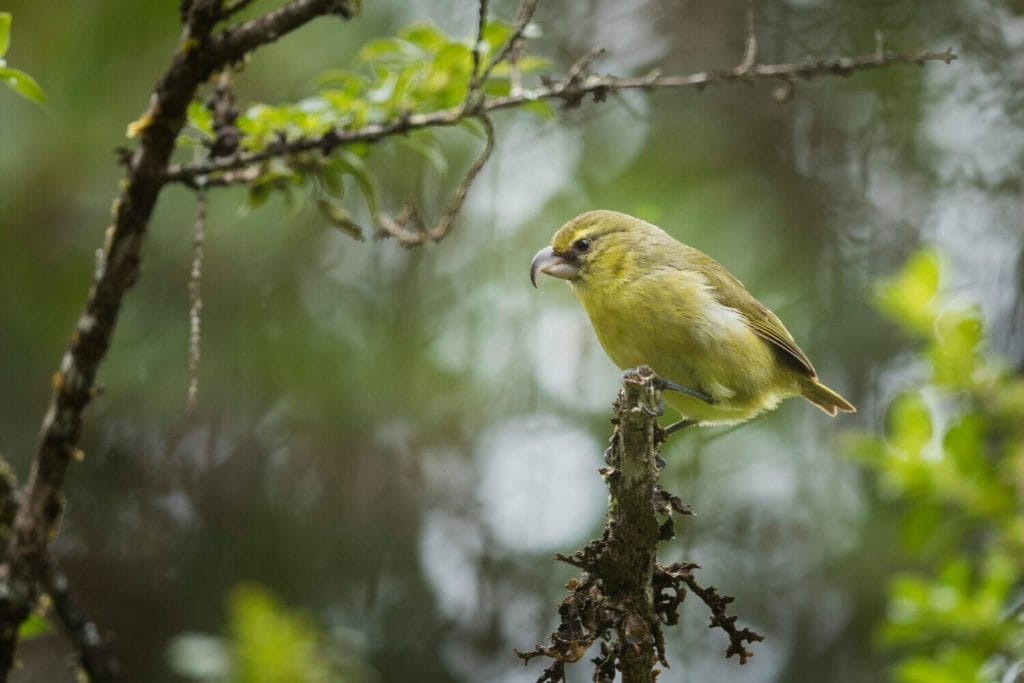
Identification and Size
The Maui Parrotbill is a very rare and unusual bird. Plain green and brown plumage is starkly contrasted by the huge bill, with the upper mandible curving well over the lower.
Length: 5.5 inches
Weight: 0.71 – 0.88 ounces

Another resident of the high forest areas of eastern Maui, the Maui Parrotbill is critically endangered and difficult to see even though it is present all year round.

Call
Diet
The parrotbill uses that formidable beak to rip open the hidey holes of pupae and larvae tucked away in the bark.
Interesting Fact
This bird likes its own company. Except for mating and brooding periods, the birds will keep a strict distance of several meters between them.
‘I‘iwi (Drepanis coccinea)

Identification and Size
Surely one of the most striking birds across the Hawaiian Islands! The vivid red color and incredible bill make this bird easy to identify.
Length: 5.5 inches
Weight: 0.6 ounces
Distribution
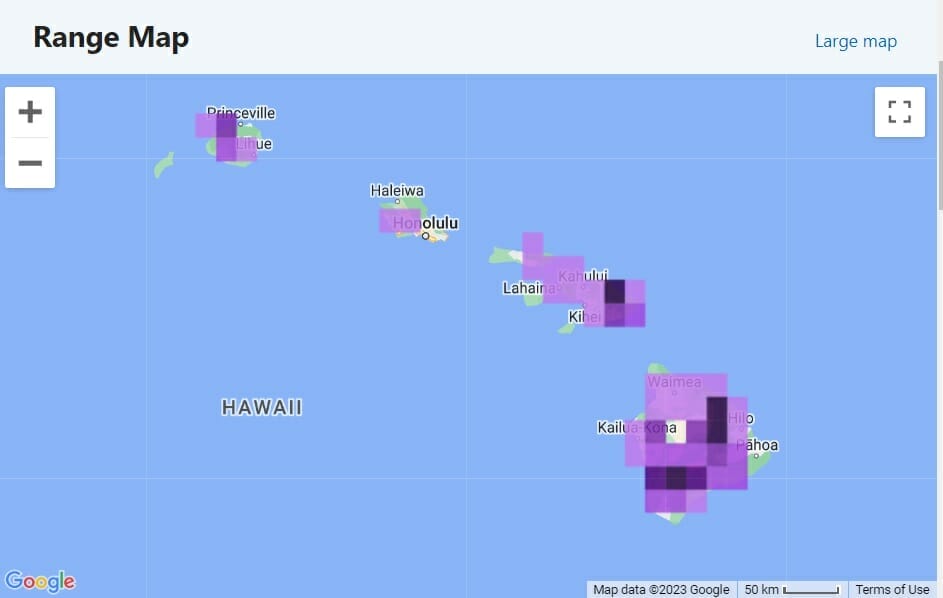
The ‘I‘iwi can be found on Kauai, Maui, and Hawaii Islands but is rarer on the others. It is seen all year round.

Call
Diet
The ‘I‘iwi prefers the nectar of the native ‘öhi’a and mämane plants but it will also eat invertebrates.
Interesting Fact
Also known as the Scarlet Hawaiian Honeycreeper, the ‘I‘iwi is an icon of the islands and can regularly be seen in promotional material about Hawaii.
FAQs
The Zebra Dove (Geopelia striata) was introduced to the state in the 1920s and is now widespread across all islands and easily seen.
I guess this is really a question for non-birders as I can’t imagine birders going past the ʻAkohekohe or the ‘I‘iwi but the answer is the Nene Goose.
Has to be the ‘I‘iwi, every time.
The sad answer is that there used to be more than 50 but pests and environmental changes means that now only 17 can be found on the Hawaiian island.
And there are our picks for Hawaiian birds. There are other exotic birds in Hawaii, both endemic and introduced, It surely is a must for any birder’s bucket list.




